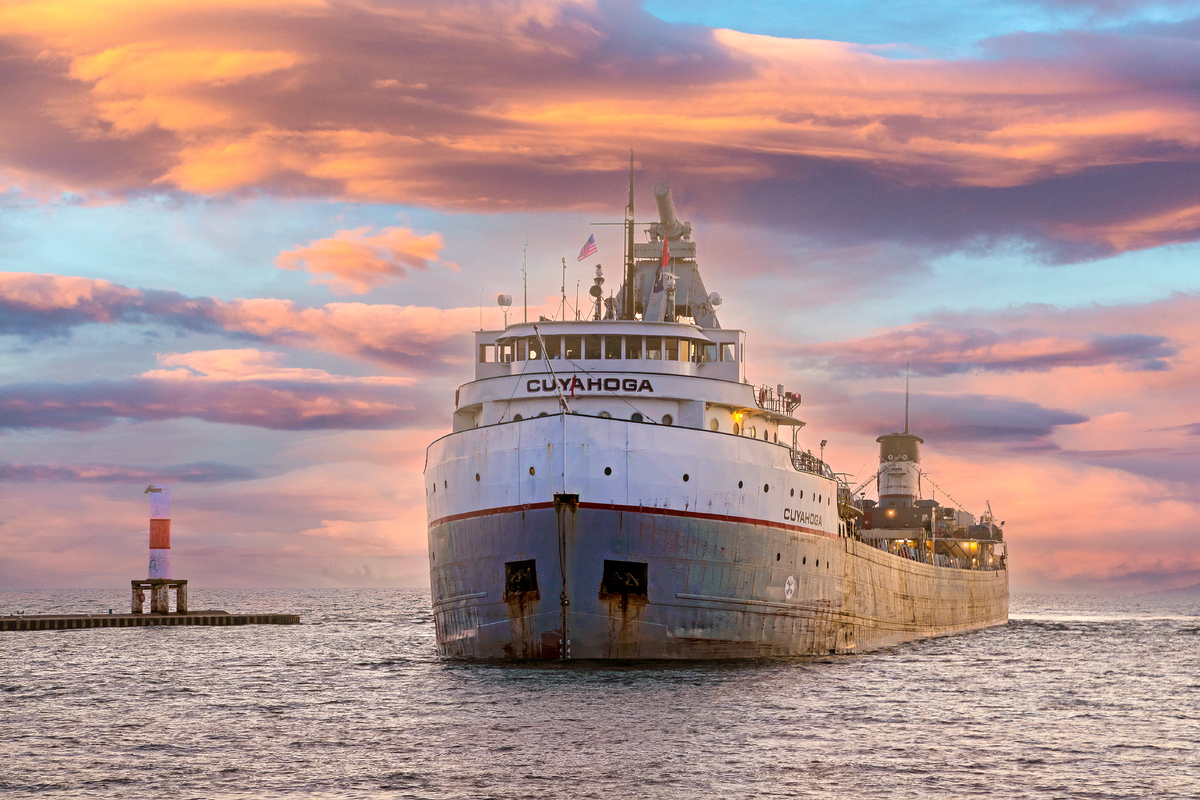American View: The Open Req of the Edmund Fitzgerald

A mate of mine recently pitched me a story to share for the American View. To be fair, his story was funny. It featured an incompetent leader, bad decisions, and an easily predicted negative outcome. I couldn’t use it, though. Even if properly anonymized and exaggerated for comic effect, there wasn’t anything in his tale for the reader beyond a moment of schadenfreude and the natural “at least I don’t work for that doofus” reaction. I strive to avoid using such stories here in my column because I feel they don’t offer readers any practical advice beyond “don’t work here.”
This unofficial policy makes it challenging to craft an all-new column every week. Eventually every writer runs out of amusing anecdotes with viable “teaching moments.” To compensate, I started branching out. I try to link interesting workplace stories to pop culture, literature, movie, and/or historical events so the stories might have greater appeal or emotional resonance. Come for the “what the heck is he up to with this?” appeal and stick around for the “I might be able to use this” practical content. That’s the intent, anyway.
I explained this to my mate. As an example, I shared a hook I’d been working on that likened a forty-five-year-old tragedy to contemporary corporate business practices. Yes, I know ... That sounds insane. It kind of is, but I think it works. Here’s the tale:
First, the tragedy. On 9th November 1975, the American Great Lakes freighter SS Edmund Fitzgerald set sail from Superior, Wisconsin with a cargo of ore, bound for Detroit, Michigan. The next day saw her steam into the teeth of a horrendous storm featuring hurricane-force winds and eleven-metre-high waves. Shortly after her last radio broadcast, the Edmund Fitzgerald went down with all hands in 88 fathoms of freezing lake water.
The Edmund Fitzgerald remains the largest ship to ever sink in Lake Superior. The bodies of her crew were never recovered and the reason for her loss has never been determined. One minute she was taking heavy seas but was “holding her own” (per her Captain’s last words) and the next minute she was gone. Compounding the tragedy, it’s conjectured from her position that she was steaming for the protection of Whitefish Bay when she went down; had she stayed afloat for just one hour longer, she probably would’ve reached safety.
I was a five and living in Michigan (not far from the lake) when the Edmund Fitzgerald sank. Normally, the rest of America would have seen an inch of column space about it in their morning newspaper the next morning and would’ve forgotten all about it before lunch. Not this time! A month after the sinking, Canadian singer-songwriter Gordon Lightfoot wrote a mournful hit song about the event. It was released in August 1976 and made it to #1 on the Canadian and #2 on the American charts in short order. Odds are, if you’re part of Generation X or older, you’ve probably heard this song at some point in your life (if not, you can hear it on YouTube).

My family visited the Great Lakes Shipwreck Museum at Whitefish Point not long after the sinking and bought some souvenirs – as you do – including a book that speculated on the possible causes of her loss. These theories featured severe seas, rogue waves, shoaling, cargo hold flooding, structural failure, a pirate attack, and … wait for it! … UFOs. Yes, in the late 1970s conspiracy enthusiasts speculated that the big freighter was capsized by aliens.
So, yeah. I knew a lot about this tragedy as a kid and was captivated by it. Even though the disaster had nothing to do with me personally, the story stuck in my head. I think the last time I ran into anyone else who knew about the wreck was in 1989 when I heard a professor at Texas A&M singing the Gordon Lightfoot tune to a bar full of inebriated billiards players.
So, what the heck does this footnote in history have to do with modern business (my mate asked)? The wreck itself … not so much. Not directly anyway. It’s the lessons learned from it, I said, that are timeless and directly applicable to leaders at all levels.
Setting aside the ludicrous “aliens did it” fantasy, nearly every probable cause of the entirely preventable disaster could be attributable to human leadership failures. These included unsafe vessel design, unsafe modifications, overloading, lack of critical instrumentation, prior hull damage, a bad weather forecast, a captain who was too cavalier about sailing in storms, and improperly secured hatches, Let’s go over a few of those failures in slightly more detail:
First, lake freighters of Edmund Fitzgerald’s generation were essentially giant tubs. If they took on water, the lack of watertight bulkheads in the cargo hold would send the vessel to the seafloor like an express elevator. The owners of the freighter supposedly knew ten years before the disaster that they needed to retrofit their ships … and didn’t.
Worse, the Fitzgerald had no sensors to detect water filling into the hold … and no pumps to remove water from the hold if they somehow discovered it. Twenty years after the sinking, I read an article suggesting that the giant cargo hold covers meant to keep water from flooding the hold hadn’t been properly secured and had been dislodged or lost in the heavy seas, allowing the 11-metre waves to fill up the hold in mere minutes.
Second, the captain allegedly had a history of overloading his ship and of charging into dangerous seas with little regard for the safety of his ship or his crew. Another freighter captain who knew him described the Fitzgerald’s skipper as “negligent” and attributed his willingness to sail in dangerous conditions to being a causal factor in the Fitzgerald’s sinking.
Third, the captain seemingly had little regard for maintenance on his vessel (notice a trend here?). It was alleged that he didn’t keep up with required scheduled repairs and didn’t hold his crew accountable for conducting preventative maintenance checks and services. An expert examined photographs of welds on Fitzgerald and stated, "the hull was just being held together with patching plates.” Even though the captain complained about atypical and dangerous instability and frightening control issues in rough seas, he seemingly didn’t take action to diagnose or fix his ship prior its final voyage.

Each of these decisions was an acceptance of risk made by the captain on behalf of his 28 crewmen. Perhaps one or more of these decisions directly contributed to her loss. Perhaps not. It seems likely that this disaster could have been prevented had those people in charge – the captain especially – had made responsible decisions either on the day she sailed or in the years preceding it.
“BUT WHAT ABOUT THE BUISSNESS-Y BUSIENSS LINK?” my mate howled in frustration? “WHAT’S YOUR POINT?!?”
“Think it through,” I said. Imagine you’re the CEO of Oglebay Norton Corporation – the operator of the SS Edmund Fitzgerald – and it’s December 1975. You’ve just lost your largest vessel and its crew in a nationally publicized disaster. Newsreaders and regulators are questioning your organization’s fitness to operate your fleet. Allegations have been made that leadership failures throughout the chain of command were to blame for the unnecessary hazarding of an $8 million asset and for the loss of 29 employees. You have contracts to fulfil and need to hire replacements for the lost sailors. What essential qualifications and requirements do you include in the new job listings?
That question stopped my mate cold. It’s a conundrum, isn’t it? When you investigate the disaster, find reasonable evidence that leaders and/or key stakeholders were negligent in their decisions, then it behoves you to hire people who won’t make those same mistakes again. That means changing the requirements and possibly the selection process from the standards you used to hire the original personnel. However, your organisation’s every move will be scrutinized by people looking to fix blame. Changing what you want out of a replacement hire might signal to the world that the person you’re replacing might have been negligent … and might make you seem negligent for having hired them and/or for having failed to correct them. Lawsuit time!
On the other hand, if you go “shields up” and prioritise protecting your organisation’s reputation by pretending that everything your org did was optimal and correct, then the same poor hiring and oversight practices that indirectly led to the loss of your biggest ship are likely to happen again. Failure to identify root causes and take corrective action strongly suggest that a repeat of the disaster is inevitable. As Jessie Porter quipped six years after the sinking, “If you always do what you’ve always done, you always get what you’ve always gotten.”
So, I put it to my mate again: if you’re the Big Boss at ONC in December 1975, what do you do? Do you prioritise your workers’ lives by fixing problems that ffect their safety even it means you’re forced to endure the angry condemnations that will follow? Or do you prioritise your org’s survival, stick doggedly with the proven-inadequate status quo, and run the risk that you’ll repeat a proven inexcusable mistake? What do you write in that open req for the new ship’s crew?
That’s the sort of damned-if-you-do decision that senior leaders are forced make all the time. True, most workplace disasters don’t involve a body count. Still, mature organisations seem to constantly make seemingly daft decisions that result in staggering losses, ranging from botched ERP installations to botched cloud implementations to botched outsourcing contracts to … well, you get the idea. In every “business disaster” there are valuable lessons to be learned. Who did what, when, and why? What could and should have been done differently? What warning signs were ignored or misunderstood? Why did we fail?

Business professors claim that a mature organisation always faces these issues head on, learns from them, and evolves. The accept responsibility for their mistakes and value accountability and continuous improvement over short-term loss-avoidance. This assertion, while optimal in the ideal world, does not reflect the world we live it. See ENRON et al.
Most people are genuinely awful at making rational, responsible decisions that deal with long-term problems. Harvard University psychology professor Daniel Gilbert explained this on NPR’s Talk of the Nation program back in 2006. Put simply, human brains are still largely mammalian; hard-wired to react to sudden threats. While humans can envision their own near future, we’re challenged when trying to factor the long term. “We don’t respond to long-term threats with nearly as much vigor and venom as we do to clear and present dangers”
That in mind, it should come as no surprise that business leaders are far more likely to consider a short-term threat – like negative press, lawsuits, falling share prices, or reactive firings – to be the most important danger to address rather than much worse long-terms threats like continuing to allow rogue captains to keep piloting their unsafe and overloaded vessels into inevitable winter storms on the Great Lakes. Leaders will, thanks in no small part to their biological blind spots, will make poor decisions unless held to account.
There’s the link: the wreck of the SS Edmund Fitzgerald 45 years ago still has deeply poignant and valuable lessons to teach us. Lessons, I believe, that directly apply to how we reflexively sabotage ourselves, do wrong by our organisation, and either repeat or exacerbate preventable mistakes rather than learning from them. The first step to breaking this cycle, I argue, is to realize why we keep making bad decisions that seem appropriate while we’re making them but are irrefutably abysmal in retrospect.
“… and the best way to get that sort of challenging idea across,” I told my mate, “Is to introduce a complex idea with an interesting story. Get your reader emotionally involved and curious first, then bring in the science or analysis. People are more likely to listen and to remember your argument if you get them interested in the story first.”
That exchange ended with the ironic realization that I’d made my own poor decision based on short-term thinking: I’d gotten to wrapped up in arguing my point that I hadn’t noticed my mate signalling our server to stick me with the lunch bill. Proving, I suppose, that we’re all never too old to learn.

Keil Hubert
You may also like
Most Viewed
23-29 Hendon Lane, London, N3 1RT
23-29 Hendon Lane, London, N3 1RT
020 8349 4363
© 2024, Lyonsdown Limited. Business Reporter® is a registered trademark of Lyonsdown Ltd. VAT registration number: 830519543





